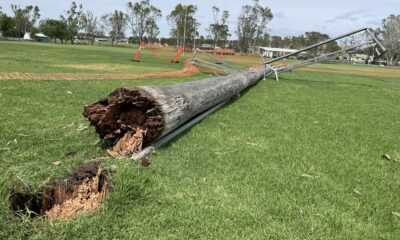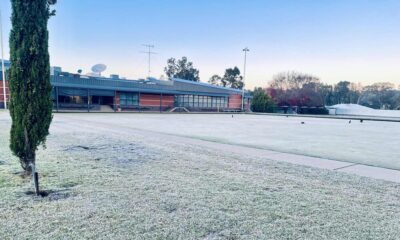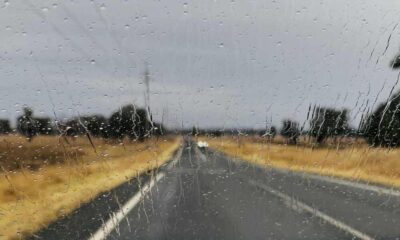Local
Pressure mounts as drought bites deep: Junee records 30mm of rain in 100 days
MORE than half of Junee Shire is now officially in drought, with worsening conditions pushing farmers to their limits as they face tough decisions and cling to hope for late-season rain.
The latest data from the NSW Department of Primary Industries and Regional Development (DPIRD) reveals 54.6 per cent of Junee Shire is drought-declared, with the remaining 45.4 per cent classified as “drought-affected”.
The figures position Junee as the third most drought-impacted local government area in New South Wales—behind only Cootamundra-Gundagai (76.7%) and the #SnowyValleys (66.5%).
RAPID DESCENT INTO DROUGHT
It’s the driest the region has been since the Black Summer of 2019–2020 — and after four years of unusually wet seasons under a rare triple-dip La Niña, the shift has been swift and brutal for many.
It took just 90 days for eastern Riverina towns like Nangus, Gundagai, Coolac, Tumut and Adelong to slip into drought after the first signs of drying emerged in early autumn 2024.
Thanks to a few extra bursts of rainfall, Junee’s descent has been slower — but no less severe.
Nine of the past 12 months in Junee have been significantly drier than average.
Rainfall was consistently below average for six straight months from May to October 2024, before a brief reprieve in November and early December saw 170mm fall in just 32 days.
Then, the skies closed, with a mere 23mm of rain falling across the Shire from December 10 to February 9.
A burst of storms on February 10 dumped 60mm in just six hours—raising hopes—but much of it turned to runoff.
That was the last significant rain event.
In the 98 days since, only 34.2mm has fallen across the district. Meanwhile, Sydney’s copped 420mm in that time—more than 300mm above the city’s average.
April delivered just 4.4mm, making it Junee’s driest April since before the Black Summer bushfires.
March also saw reduced rainfall and a dust storm—the town’s first in five years—while January brought just 9.2mm, far below the 40mm average.
So far in 2025, Junee has recorded just 116mm of rain. By comparison, the town had seen 170mm by this time in 2024, 230mm in 2023, and over 300mm before winter in 2022.
NO RELIEF IN SIGHT
The NSW DPI formally declared widespread drought across the Cootamundra electorate in late April. But many on the land had already accepted the grim reality.
Water and fodder are being trucked in at enormous cost and livestock markets are flooded as producers reduce herds they can no longer afford to feed.
Others are dry sowing—seeding into dust—in a desperate bid to keep production on track, gambling on the hope of late-breaking rain.
But the Bureau of Meteorology’s May–July outlook offers little hope, with warmer-than-normal temperatures and below-average rainfall expected to dominate southern NSW.
Without regular cold fronts from the Southern Ocean pushing north — a pattern meteorologists say is unlikely before mid-winter — meaningful drought relief appears out of reach.
Apart from the medium chance of a few showers this coming weekend, no substantial rainfall is forecast for Junee for the foreseeable future.
In fact, the DPIRD warns drought conditions will likely intensify across the Hunter, Central Tablelands, and the western slopes in the weeks ahead.
“WHEN IT’S DRY, WE ALL FEEL IT”
The DPI’s latest drought map shows 51.8 per cent of the Riverina is now drought-affected, and 13.1 per cent officially in drought.
Member for Cootamundra Steph Cooke MP said the toll on farmers and regional communities is already severe.
“We’ve got crops in the ground and desperately need rain to bring them on,” she said.
“From Naranderra to the Bland, Temora, Cootamundra, Junee up through Cowra and Gooloogong—it’s dry right across our electorate.”
“The resilience of our farmers is remarkable, but when it’s dry, everyone feels it—on the land and in our towns.”
LIVESTOCK SALES SURGE
With feed and water in short supply, farmers are spending tens of thousands of dollars on hay and grain or offloading livestock they can no longer sustain.
In the fortnight since May 5, a staggering 17,400 head of cattle and 146,000 sheep and lambs have passed through the Wagga Livestock Marketing Centre—a sharp rise that reflects the severity of the crisis.
While some producers are transporting stock to greener pastures, others are trapped—financially stretched, emotionally exhausted, and unable to sustain operations.
In a heartfelt address to Parliament last week, Ms Cooke painted a stark picture of the crisis.
“This is what drought looks like,” she said. “It creeps in, stripping paddocks bare, draining dams and bank accounts, and exhausting people to the core.”
“Our farmers are doing their part. Many learned the lessons of the 2017–2020 tinderbox drought and invested in hay and grain storage, water infrastructure, and on-farm feeding systems.”
“But you can’t store what doesn’t grow. And right now, what crop is in the ground is at risk.”
FODDER FRENZY
With supplies dwindling, fodder prices are soaring.
Feed Central managing director Tim Ford told the ABC that his company had sold more hay in a single week than during any previous drought in the past 20 years.
“Our phones and keyboards went off this week—across the country, but especially from Dubbo through southern Victoria and across to South Australia,” he said.
Cereal hay is now fetching up to $500 per tonne in central South Australia and $480 in south-west Victoria. Lucerne has jumped $30 per tonne, now selling for between $410 and $550 in parts of Victoria.
The Australian Fodder Industry Association warns many regions are on the brink.
“Reports state the region is going to run out of hay very soon,” AFIA said. “If growers do not get rain in the next month, it is going to be a disaster for the whole state.”
WHERE’S THE PLAN?
In Question Time last week, Ms Cooke pressed the Deputy Premier Prue Car over the government’s lack of a drought response plan, urging immediate support for struggling farmers.
But Car gave little reassurance, saying only that the responsible Minister would “get prepared”.
“We will take that issue and ensure the Minister is getting prepared to ensure we are in a position to support those communities,” she said.
Meanwhile, other states are already stepping up.
South Australia has committed $73 million in drought assistance, while Victoria last week added $15.9 million to its $13.5 million package announced in September.
Tasmania is also rolling out a $5 million support program.
But in New South Wales, many farmers say they feel forgotten—and as the dry spell drags on, the need for action is growing by the day.
“Many in my electorate already need immediate relief, including transport subsidies for stock, water and fodder,” Ms Cooke said.
And while drought might not look as dramatic as flood or fire, she argued, its effects are every bit as devastating.
“Unlike flood or bushfire, there’s no warning on the Hazards Near Me app. No one rushes in with hoses or sandbags,” she told Parliament.
“And still, our farmers are expected to bear the burden until it becomes politically convenient to act.”
CALL FOR LONG TERM ACTION
Ms Cooke says it’s time to treat drought not as an occasional emergency, but as a recurring national threat that demands long-term, strategic investment.
“We cannot keep responding to disasters by waiting for them to break us,” she said. “We must continue to shift from response and recovery to mitigation and preparedness.”
As the then Minister for Emergency Services, Resilience and Flood Recovery, Ms Cooke helped establish the NSW Reconstruction Authority in November 2022.
“This was one of my proudest achievements,” she said, pointing to the act as a model for what’s possible when government’s think long term.
“In Queensland, the QRA is regarded as nation-leading. It has the authority, funding, and whole-of-government focus needed to drive real resilience. It’s time drought was treated the same.”
“Not as an exception but a recurring risk requiring the same level of coordination, investment, and forward thinking.”
Cooke said a NSW Fodder Reserve initiative, better drought preparedness planning, and long-term infrastructure investment are urgently needed.
“Above all, we must recognise that drought, like any other natural disaster, requires a serious, structured, and sustained response,” she said.
“For many parts of NSW, the next drought is already here. But it’s not too late.”
“We can rethink our approach, back our farmers and communities with the urgency and seriousness we would for any other emergency. By preparing now, the task of rebuilding is not insurmountable later.”
SUPPORT AVAILABLE NOW
As the crisis deepens, Ms Cooke is urging local landholders to access the support services currently available.
Farmers can visit www.droughthub.nsw.gov.au for information on financial assistance, transport subsidies, concessional loans, and resources to help manage the ongoing impacts of drought.
Landholders are also encouraged to use the NSW DPI Farm Tracker app, which allows users to monitor rainfall, seasonal trends, and climate data specific to their properties.
Mental health support remains a critical need. Services such as the Rural Adversity Mental Health Program (RAMHP) and Rural Aid continue to offer counselling and emotional support to those struggling with the psychological toll of prolonged dry conditions.
























Pingback: Heaviest rain in 100 days expected as weather system deepens
Pingback: Late-season rain brings brief relief to drought-hit farmers